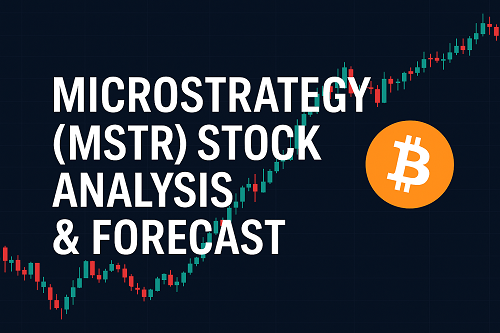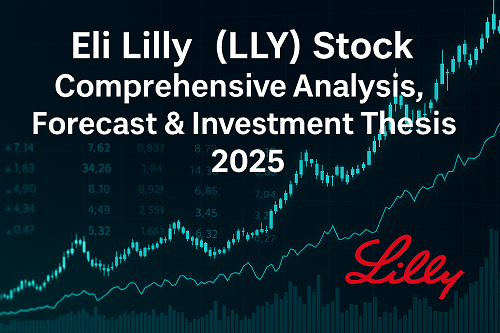MicroStrategy (NASDAQ: MSTR) is a publicly traded software & business intelligence firm that has become synonymous with a large-scale Bitcoin allocation. The stock’s performance is uniquely tethered to the volatile crypto market, making its risk/reward profile distinct from typical tech names. For investors interested in MicroStrategy stock, this guide will unpack MSTR’s fundamentals, Bitcoin exposure, valuation models, technicals, multiple scenarios, trade strategies, and key risk factors to watch heading into 2025.
Company Overview & Business Model of Microstrategy Stock
Business & Core Operations
- Microstrategy stock was founded in 1989, focusing on enterprise analytics, business intelligence (BI), data analytics, and software services.
- Over time, it built a client base of large enterprises needing dashboards, reporting, and data-driven decision tools.
- However, in recent years, the company’s identity has shifted — it is now commonly perceived as a “proxy Bitcoin play.”
Financials & Revenue Streams
- MicroStrategy’s recurring revenue comes from software licenses, subscription services, and support/maintenance.
- As of its most recent SEC filings, the software operations show modest growth but high margin pressures, especially when compared to high-growth pure software peers.
- Because Bitcoin holdings do not generate operating revenue, a significant portion of shareholder returns depends on capital gains from crypto exposure.
Balance Sheet & Leverage
- Key metrics: cash, debt levels, debt maturities, interest coverage, and liquidity buffers.
- One must examine how much debt is being used to acquire crypto, how interest rate cycles impact debt servicing, and how that bleeds into overall risk.
MicroStrategy stock Bitcoin Strategy
This is the crux of what makes MSTR unique and volatile.
Scale of Bitcoin Holdings
- Microstrategy stock holds a substantial amount of BTC (hundreds of millions of dollars worth) in its treasury.
- The company has made repeated purchases over time, sometimes using equity issuances or debt to fund additional accumulation.
Rationale & Messaging
- The management argues that Bitcoin is a store of value and better reserve asset compared to holding cash, particularly in environments of inflation and currency depreciation.
- They position Bitcoin as a hedge vs fiat, and use it as a non-correlated asset (though in practice, BTC now behaves with its own risk cycles).
Accounting & Impairment Risks
- Bitcoin is treated as an intangible asset under U.S. GAAP, meaning it is not amortized but subject to impairment if fair value falls below carrying value.
- If valuations drop significantly, Microstrategy stock may need to book impairment losses, which can drag earnings.
- There is no upside revaluation bump: if BTC recovers, they cannot credit gains until sold (or under new accounting rules).
Correlation Between BTC and MSTR
- Empirically, MSTR’s stock price correlates strongly to Bitcoin’s price moves — often with beta > 1.
- On BTC rallies, MSTR may amplify upside; on drawdowns, MSTR may suffer exaggerated downside.
Recent Performance & Share Price Drivers
Here we look at historical trends, catalysts, correlation metrics, and what moves the stock.
Stock vs. Bitcoin Performance
- A chart overlaying BTC price vs MSTR stock over 1, 3, 5 years shows divergence, amplification, and decoupling periods.
- Compute correlation coefficient, rolling window (e.g., 120-day) to show strength of linkage.
Key Catalysts to Monitor
- Further BTC accumulation announcements
- Changes in capital raising (debt/equity)
- Macro monetary policy (rate hikes, inflation, dollar strength)
- Institutional interest/arbitrage flows
- Regulatory or tax shifts affecting Bitcoin or public companies holding crypto
Investor Sentiment & Social Signals
- On-chain metrics (Bitcoin wallet flows, institutional wallet inflows)
- Media sentiment, Google Trends for “MSTR stock,” “Microstrategy stock buy BTC”
Insider & Institutional Activity
- Review the latest 13F filings, institutional accumulation or trimming.
- Insider buying/selling: CEO and executive activity, confidence signals.
Fundamental Valuation
Valuing MSTR is tricky due to its hybrid nature (software business + Bitcoin treasury). Here are approaches and considerations:
Sum-of-the-Parts (SOTP) / NAV Approach
Component A: Software / BI Business Value
- Use a revenue multiple approach (EV/Revenue or EV/EBITDA) comparable to BI companies.
- Adjust for growth prospects, margins, and risk.
Component B: Bitcoin Treasury Value
- Simply assign market value to BTC holdings (minus debt/interest load).
- Subtract adjustments for impairment risk, holding costs, custody fees.
Thus:
Estimated intrinsic value = Value_Software + (BTC_holdings − Net Debt_adjusted)
You might discount BTC to reflect volatility or illiquidity.
Discounted Cash Flow (DCF) – with caution
- Model cash flows from software business only; exclude BTC (since it’s non-operating).
- Discount at higher WACC due to cyclicality and risk.
- Add present value (or fair valuation) of crypto holdings.
Relative Multiples & Peer Benchmarking
- Compare to other software/BI peers, adjusting downward given high volatility.
- Also compare to “crypto proxy stocks” (if any) or large firms with crypto exposure.
Sensitivity Table
- Run multiple scenarios (bull, base, bear) altering BTC price, software growth, margins, and discount rate.
- Show value per share sensitivity to key assumptions (e.g. BTC ± 20%, EBITDA margin ± 5%).
Example Table (simplified):
| Scenario | BTC Price | BTC Value / Share | Software Value / Share | Net Debt | Estimated Value / Share |
|---|---|---|---|---|---|
| Bear | $40,000 | $X | $Y | –$Z | $V1 |
| Base | $60,000 | $X’ | $Y’ | –$Z | $V2 |
| Bull | $100,000 | $X” | $Y” | –$Z | $V3 |
Use it to anchor trade ideas.
Technical & Sentiment Analysis
Beyond fundamentals, traders will want technicals, chart setups, and sentiment signals.
Key Price Levels & Trend Structure
- Identify zones of support/resistance (multi-year, annual, monthly).
- Use trendlines, channels, Fibonacci retracements, moving average zones (50/200 DMA).
- Recognize patterns (head & shoulders, flags, double tops/bottoms).
Momentum & Oscillators
- RSI (14), MACD, Stochastic – identify overbought/oversold or divergence.
- On-volume strength (Volume-Price trends) and volume spikes.
Moving Averages & Moving Average Crosses
- Watch for 50-DMA crossing 200-DMA (golden/death cross).
- Watch price relative to moving average envelope bands or Bollinger Bands.
Sentiment Indicators
- Put/Call ratio for MSTR options.
- Short interest data: short % of float, days to cover, changes over time.
- Social sentiment: Reddit/StockTwits mentions, sentiment polarity shifts.
Scenarios & Forecasts for 2025
Craft plausible future paths for MSTR based on BTC and software business performance.
Base Case (Moderate Growth)
- Assume Bitcoin trades in a mid-range, e.g., $50,000–70,000.
- Software business grows 8–12% annually, stable margins.
- MSTR valuation per share might land in a band: e.g., $400–600.
Bull Case (Crypto Boom)
- BTC surges to $100,000+.
- Microstrategy stock continues accumulation; software business accelerates via new contracts.
- MSTR could rally > 2–3× from current levels (depending where it starts).
Bear Case (Crypto Winter / Headwinds)
- BTC collapses to $20,000–30,000.
- Impairment charges, margin contraction in software, debt stress.
- MSTR might drop more than 50%, possibly below break-even levels.
Trigger-Based Pathways
- If MSTR breaks above resistance at $X with volume, target upward to $Y.
- If BTC moves below support at $X, MSTR likely to cascade downward with amplified losses.
Trading Strategies & Entry / Exit Frameworks
Here are structured ideas, risk controls, and actionable setups.
Strategy A: Long Biased (Core Position)
- Use dollar-cost averaging to accumulate both MSTR and/or Bitcoin.
- Entry zones: lean in near technical support, or when BTC shows rebound strength.
- Use trailing stops or volatility-based stops (e.g., ATR multiples).
Strategy B: Tacticals & Leveraged Moves
- Use options: long calls, call spreads, or LEAPS with limited capital exposure.
- Use small position size if volatility is high.
- Consider hedged positions: e.g. long MSTR + short BTC (if you see divergence).
Strategy C: Pair Trade / Arbitrage Concept
- If BTC vs MSTR ratio deviates significantly from historical norms, consider long the undervalued side, short the overvalued side.
- Monitor reversion over medium-term windows (weeks to months).
Strategy D: Risk Off / Defensive Exit Plan
- If BTC drops below critical threshold, close MSTR exposure to prevent cascading losses.
- Watch debt servicing events or earnings announcements as inflection points.
- Use options to protect downside (buy puts or hedges).
Risk Management Rules
- Never allocate more than a small % (e.g. 2–5 %) of capital to a high-volatility name.
- Use position sizing, maximum drawdown thresholds, stop-loss discipline.
- Keep cash reserved for opportunistic entries in strong dips.
Risks & Watch-Outs
To be balanced, one must consider the risks:
- Bitcoin Volatility — BTC drop will heavily drag MSTR, so it’s extremely sensitive to crypto market cycles.
- Accounting Impairment — GAAP rules can force write-downs, compressing earnings even if long-term value remains.
- Rising Interest Rates / Leverage Costs — If the company borrowes against BTC or uses debt to accumulate, interest costs can eat into returns.
- Regulation / Tax Risk — Changes in crypto taxation, accounting standards, or restrictions on corporate holdings pose structural risks.
- Liquidity & Market Sentiment Shifts — If investor sentiment sours or liquidity dries, precipitous moves can amplify.
- Business Execution Risk — The core software business must remain viable; neglect or competitive losses may hurt that base.
- Concentration Risk — The company is highly concentrated; a macro shock could hit both crypto and tech sectors simultaneously.
- Operational / Custody Risks — Crypto storage, security, hacking, or lost keys are real exposures.
Conclusion & Key Takeaways
- Unique risk/return profile: MSTR is not a pure software stock. It behaves more like a leveraged bet on Bitcoin with some software revenue cushion.
- Strong upside, strong downside: In bullish crypto cycles, the stock could outperform Bitcoin; in downturns, it can underperform heavily.
- Valuation is art + science: Use a combination of SOTP, sensitivity tables, and scenario modeling to frame value.
- Trade with discipline: Exploit technical zones, use hedges, and strictly manage drawdowns.
- Stay alert to triggers: New BTC accumulation, debt changes, macro rates, regulatory shifts—all can act as catalysts.





 XAUT-USD
XAUT-USD  AMD
AMD  MARA
MARA  SHOP
SHOP  BULL
BULL  CL=F
CL=F